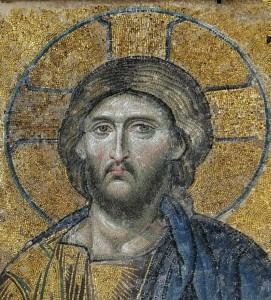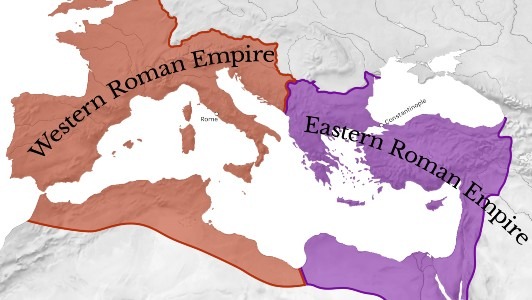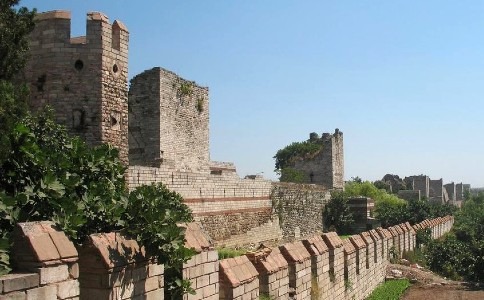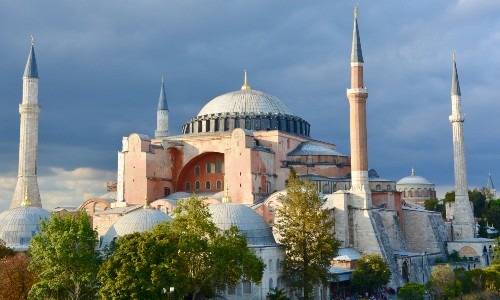MedievalReporter.com
Covering history's most marvelous millennium
Join our newsletter!

Covering history's most marvelous millennium
Covering history's most marvelous millennium
The Byzantines were among the longest-living civilizations of the Middle Ages. Some people even date the end of the Medieval Era at the fall of their capital city, Constantinople. During a major part of its existence, the Byzantine Empire was the center of the medieval world.
Frankish kings sought Byzantine recognition, Slavic tribes incorporated their religion, and Vikings sailed down the Russian rivers to serve in the imperial army. Over time, this gravitas attracted unwanted attention. During its long existence, the Byzantine Empire fought many wars - with Arabs, Bulgarians, Crusaders, Normans, Venetians, and so on. Ultimately, it was the epoch-turning struggle with the Turks that spelled the end for the Byzantines.
By then, their empire had survived for over a thousand years.
This is a short intro from our Medieval Guidebook. Dive deeper into the subject by reading our articles about it.

The Byzantine Empire, as a name, was a modern invention to describe the Eastern Roman Empire. During Late Antiquity, the Roman Empire had grown so large that it became hard to govern. Rome was simply too far away from the all-important eastern provinces. Therefore, emperor Constantine moved the capital of the empire east, to Byzantium. He renamed it after himself: Constantinople.
This proved inadequate to solve the Roman Empire’s administrative problems. It was still too big for a single emperor to rule effectively. A split had to be made. Consequently, the empire was divided into the (Latin) Western Roman Empire and the (Greek) Eastern Roman Empire. In our times, the latter is called the Byzantine Empire - after the old name of its capital city.
The Byzantines considered themselves Romans but spoke Greek. They called their empire Romania. It was a Roman state embedded in Greek culture. There was Roman law but Orthodox religion. For all intents and purposes, the empire was a Greco-Roman hybrid.

An important aspect of the Byzantine Empire was its central organization. Several times, invading armies conquered province after province. When they ended up under Constantinople’s mighty walls, they found out that - without taking the city - they hadn’t achieved all that much. The capital made up a large part of the empire’s economy and was well-defended. During all those long centuries, Constantinople was only taken twice.

Furthermore, the Byzantine Empire inherited the Roman way of warfare: disciplined, strategic and well-organized. Its heavy infantry - a trademark of the Roman legions of old - continued its overall successful track record against the “barbarians” still fighting against the Byzantines. In the meantime, the army’s ranks were expanded with heavy cavalry in order to withstand new enemies that employed steppe- or desert-based warfare: Arabs, Bulgars, Persians, and so on. The famous cataphract riders - meaning: completely armored - enjoyed great success against these civilizations. Additionally, the Byzantine navy wielded “Greek fire” - which burned even on water - that allowed it to score many crucial victories.
This military system was backed by one of the most robust economies of the Middle Ages. Constantinople was a major trade hub, well-positioned between East and West. The Byzantine state was usually very wealthy, which allowed it to maintain a large army or to bribe major rivals.
One of these rivals, the Turks, turned out to be its mortal enemy. Their entry into the region sparked a Byzantine plea for help to the West, which resulted in the Crusades. Unfortunately, one of these expeditions sacked Constantinople in 1204 CE - the first time the city was taken. This was such a lethal blow to the Empire that it had a hard time recovering. Two centuries later, another Turkish state - the Ottoman Empire - conquered the Byzantine capital for good - and renamed it Istanbul.

- advertisement -
- article continues below -
It has been said that the Byzantine Empire preserved the legacy of Classical Antiquity. As “heirs” to the Roman Empire, they carried Greco-Roman culture forward throughout the Middle Ages. The conquest of Constantinople, then, would have put to flight a host of Byzantine monks and scholars. They were supposed to have fled west, where they fueled the Italian Renaissance with their classical books and manuscripts. Alas, this story fits too neatly.
In a way - as the most powerful economic, cultural, and military force in Europe for a long time - the Byzantine Empire did shield the christian world from Persian, Arab, Mongol and - for a while - Turkish attacks from the east. But remember what we talked about earlier: the Empire was culturally Greek. Its writers and authors did indeed preserve a lot of ancient Greek culture. Latin texts, however, were more often copied in the West - and better maintained, too. To illustrate matters: Byzantine libraries contained the entirety of Plato’s Dialogues but were void of Julius Caesar’s De Bello Gallico - whereas Frankish clergy reproduced Ceasar’s works incessantly but were mostly oblivious to Plato.
In short, a part of Classical Antiquity lived on in the (Greek) Byzantine Empire. Other parts were maintained in (Latin) Western Europe. The Arabs showed great interest in the ancient philosophers as well and preserved yet other pieces of knowledge, “reinserting” them into Europe through Reconquista Spain and Norman Italy.
So, just like every civilization ever, both the Byzantines and Western Europe built upon the cultural fundaments of Greco-Roman culture. They both integrated elements of Classical Antiquity with medieval logic, organization and business. These improvisations and adaptations were precisely how the Byzantine Empire survived for over a millennium: when it fell, it was a very different state than the Roman emperors of old had created.

Disclosure: we work hard to provide you with exclusive medieval reports and guides. To make the Middle Ages accessible to everybody, we’d like this information to remain FREE. Therefore, some of the links below are affiliate links, meaning – at no additional cost to you – we will earn a small compensation if you click through.
Grab a short intro on another civilization from our Medieval Guidebook.